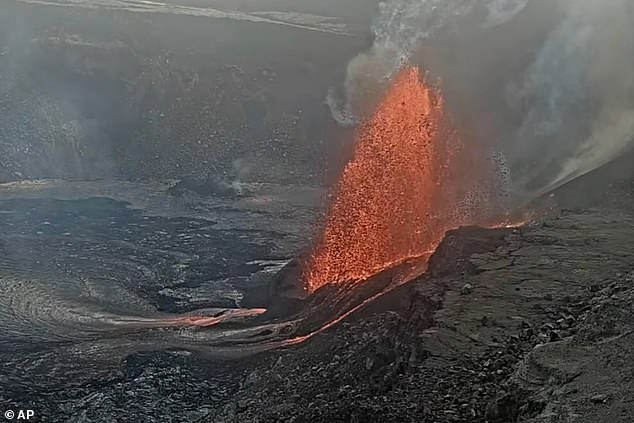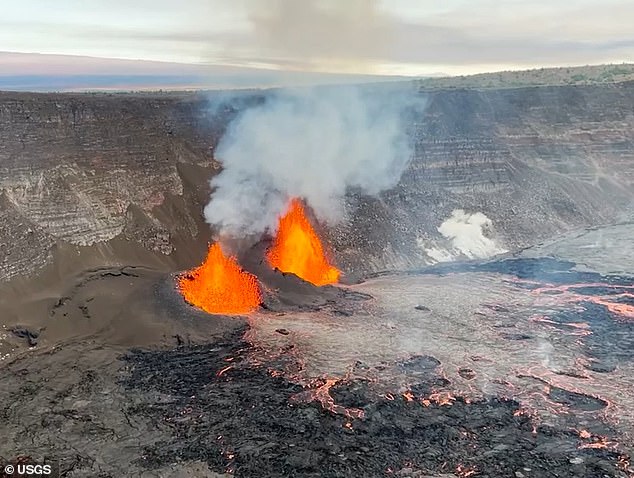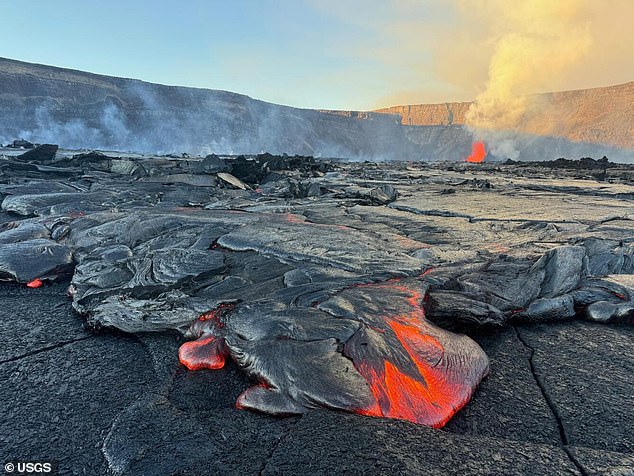Hawaii‘s Kilauea volcano is erupting, spewing hot lava hundreds of feet into the sky.
The eruption began Tuesday at the volcano’s summit crater inside Hawaii Volcanoes National Park on the Big Island, about 200 miles southeast of Honolulu.
Just after 10am local time Tuesday morning, the volcano released molten rock that flowed onto the floor of the summit crater. A half-hour later, a vent spewed an enormous column of lava 330 feet into the sky.
Early this morning, officials said Kilauea is still violently erupting, producing fountains of lava between 16 and 200 feet high.
So far, no residential areas have been threatened by lava flows.
‘Current hazards include volcanic gas emissions and windblown volcanic glass (Pele‘s Hair) that may impact Hawai’i Volcanoes National Park and nearby communities,’ the U.S. Geological Survey’s Hawaiian Volcano Observatory said in a statement.
Volcanic gas and ash can irritate the eyes and respiratory system, and lead to other symptoms such as vomiting, dizziness, headaches, difficulty breathing, visual disturbances and tremors, according to the Centers for Disease Control and Prevention (CDC).
The CDC also notes that long term exposure to these volcanic air pollutants can lead to lung infections such as bronchitis, and respiratory disorders such as lung disease or lung cancer.

Windblown volcanic glass, also known as Pele’s hair, can be dangerous as well.
These thin, sharp glass fibers form when gas bubbles in the lava pop at the surface and cool into gossamer strands. When blown downwind, Pele’s hair can irritate people’s eyes and skin or contaminate drinking water.
Kilauea is one of the most active volcanoes on Earth, and the most active among the five volcanos that together form the Big Island.
This is its ninth episode of eruptive activity since December 23, according to the Hawaiian Volcano Observatory.
Previous episodes have lasted between 13 hours and eight days, with brief pauses in between.
People have been flocking to overlook sites inside the national park for views of the eruption.
The Hawaiian Volcano Observatory also hosts a livestream of Kilauea’s eruptions.
This volcano is between 210,000 and 280,000 years old, but did not grow above sea level until roughly 100,000 years ago.


The longest and most destructive recorded eruption from Kilauea persisted from January 1983 to April 2018 and caused significant property damage, including the destruction of two towns in 1990 and a renowned black sand beach.
Kilauea overlaps with the eastern side of the largest volcano on Earth, the nearly 14,000-foot-tall Mauna Loa.
Just last month, researchers at the University of Hawaii at Manoa discovered that these two volcanoes share a magma source within Hawaii’s hotspot, also known as the mantle plume.
They also have their own magma sources, but magma from the shared portion of the mantle plume can travel to either Kilauea or Mauna Loa.
The volcano receiving magma from this shared area is more likely to be active, while the other ‘becomes sleepy,’ according to Aaron Pietruszka, the lead researcher on the study and an associate professor at UH Manoa.
‘Each volcano gets a boost of extra magma from the mantle from time to time. And then when that happens, its activity increases from its baseline,’ Pietruszka told Spectrum News.
He and his colleagues published their findings in the Journal of Petrology.
However, it is possible for both volcanoes to erupt at the same time because they each have their own sources of magma too.
It’s unclear whether this shared magma source is fueling the recent uptick in Kilauea’s activity.

